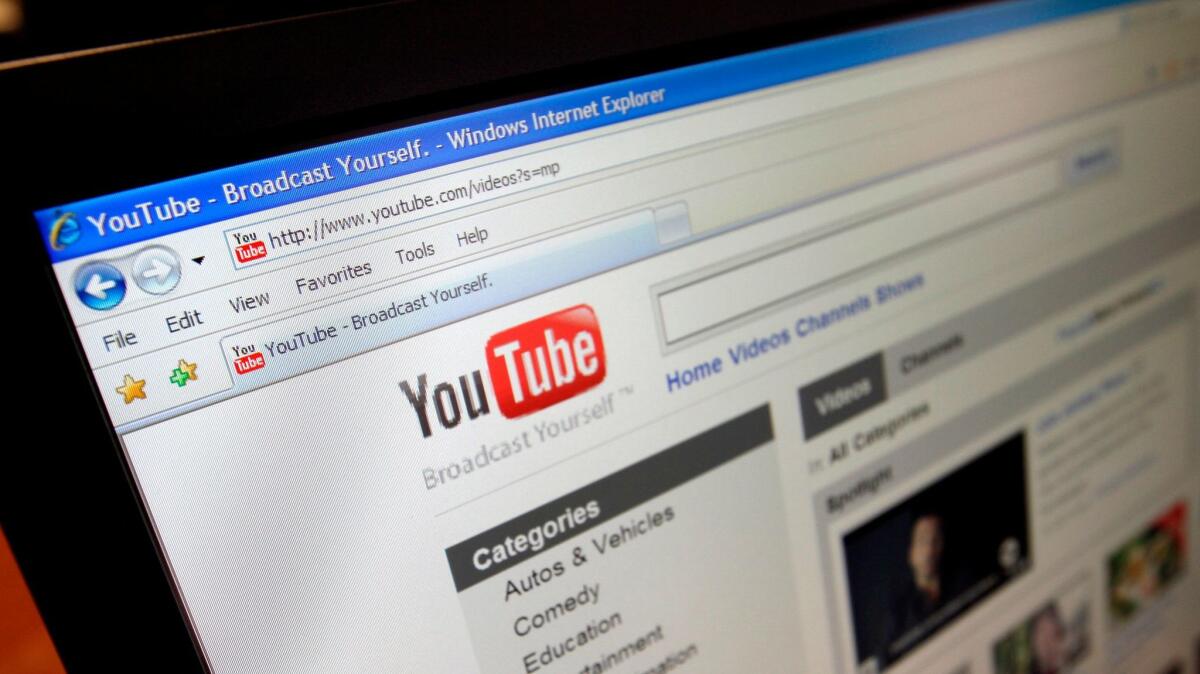Op-Ed: The tech industry is eroding copyright law. Here’s how to stop it

- Share via
Suppose a band spends months making an album in expensive recording studios, and the band’s record label releases the album on iTunes. Imagine that, by the end of the first day, all the music has been posted on YouTube, where it is available for free.
Now suppose that, the following day, the record label files a “takedown notice,” asserting copyright infringement and requesting the music be removed. Within a week, the work is taken down. Two days later, the album appears on YouTube again, posted by a different user.
So begins the copyright holder’s game of whack-a-mole.
The posting of content by users who do not hold the copyright for it is perfectly legal, under the “notice and takedown” provision of the Digital Millennium Copyright Act. It’s legal even when the copyright holder already has filed a takedown notice, as long as the work is posted by a different user. Takedown notices address instances of infringement — individual videos posted to YouTube, say — but they don’t apply generally to the actual content.
The only way to get Internet companies to honor the widely accepted understanding of fair use is to make it law.
YouTube, Google and virtually every pirate site on the Internet invokes the DMCA, over and over, to avoid prosecution for hosting content without permission from the copyright holder. Google received about 2 million takedown notices every day in 2016, according to the Silicon Valley Business Journal.
There is a growing movement to change this. Over the past few years, record companies, musicians’ rights groups and Hollywood studios have been pushing to amend copyright law so that websites like YouTube and Facebook bear the responsibility for keeping bootleg content down, a concept some are calling “notice and staydown.” In this approach, it would be up to the websites — once they have been notified — to remove unwarranted content whenever it reappears.
In response to this movement, many tech companies are encouraging their users to employ the doctrine of “fair use” in order to fight takedown notices. This is a gross distortion of the concept.
Fair use allows for the limited reproduction of content without permission from the copyright holder — emphasis on “limited.” Your local TV station can show a snippet of a football game that was broadcast by another network under fair use. There is no legal statute specifying the maximum length a video or audio clip can be, but it has long been accepted practice that a clip cannot exceed 30 seconds and that it must be quoted in a “transformative” work, such as a remix, a mashup or a hip-hop sample.
This loose definition is widely honored in the TV industry, the music industry, book publishing and academia, among other sectors. Tech companies abet the routine violation of it.
When you post something on YouTube, you can always check a box that says “fair use,” and no matter what it is, the content will go up on the site. It will go up even if you are posting a song in its entirety, and even when you acknowledge that you do not hold the copyright by leaving unchecked a box that says, “I own this piece of content.” Some tech companies are going even further. In late 2015, Google acknowledged that it is providing support to users who employ fair use as a legal defense.
Tech companies have a strong financial incentive to erode copyright law because their businesses grow in part through the recycling and repurposing of content. Copyright holders have an equally strong incentive to protect it. Faced with the deep pockets of the tech industry, copyright holders are fighting a losing battle.
The only way to get Internet companies to honor the widely accepted understanding of fair use is to make it law. Although the current legal definition makes one thing crystal clear — you cannot use a work in its entirety and still claim fair use — it leaves many aspects of the doctrine open to interpretation. The Registrar of Copyrights should codify a 30-second time limit for audio and video clips and require that content be used in a transformative or interpretive way.
With concrete guidelines in place, regulation would have to be built in. For instance, when a user asserts fair use for a work that YouTube identifies as being blocked by the copyright holder, the clip would have to be sent to a human screener for evaluation. If it is longer than 30 seconds or does not appear in a transformative work, the clip would remain blocked. YouTube already has this process in place for screening pornography, ISIS videos and the like.
The ambiguous definition of fair use allows for its continued abuse, and this abuse has become a gateway for the further eroding of copyright law. By now it is well understood that the rise of tech monopolies such as YouTube and Google has hastened the decline of publishing industries. If we don’t move to safeguard copyright law now, there will be no new content to remix.
Jonathan Taplin is the director emeritus of USC’s Annenberg Innovation Lab and the author of “Move Fast and Break Things: How Facebook, Google and Amazon Cornered Culture and Undermined Democracy,” from which this is adapted.
Follow the Opinion section on Twitter @latimesopinion or Facebook
More to Read
A cure for the common opinion
Get thought-provoking perspectives with our weekly newsletter.
You may occasionally receive promotional content from the Los Angeles Times.










